#kitchen utensils manufacturer
Explore tagged Tumblr posts
Text
Standard Cutlery Manufacturers
Royal Kitchenware is a leading Cutlery Manufacturer in India, We also prioritize the use of eco-friendly materials and sustainable practices in our manufacturing process, ensuring that our products are both beautiful and responsible.

#cutlery manufacturer#cutlery makers#flatware manufacturers#table ware suppliers#stain lesss tee lcutlery#silver cutlery#kitchen utensils manufacturer#custom cutlery#knife manufacturer#spoon maker#forks manufacturing
0 notes
Text
"The Essential Guide to Cookware: Choosing the Right Pots and Pans for Your Kitchen"
Introduction: Cookware is the unsung hero of every kitchen, silently contributing to the delicious meals we enjoy daily. Whether you're an amateur home cook or a seasoned chef, having the right cookware can make a world of difference in your culinary adventures. In this blog, we'll explore the various types of cookware, their materials, and how to choose the best pots and pans for your cooking needs.
The Fundamentals of Cookware :Before delving into the specifics, let's cover the basics. Cookware is typically categorized into two main types: pots and pans. Pots are deep vessels with high sides, while pans have flat bottoms and low sides. Each serves its unique purpose, from simmering soups in a pot to searing steaks in a pan.
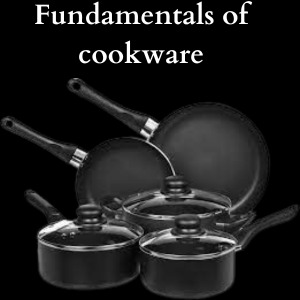
Cookware is an essential part of any kitchen, serving as the foundation for preparing delicious meals. These kitchen tools come in various shapes, sizes, and materials, each designed for specific cooking methods and recipes. Understanding the fundamentals of cookware is key to becoming a proficient cook.
Materials Matter: The material of your cookware affects how evenly it distributes heat, its durability, and its overall performance. Here are some common materials you'll encounter. Material Matter is a brand known for its innovative and sustainable cookware solutions.
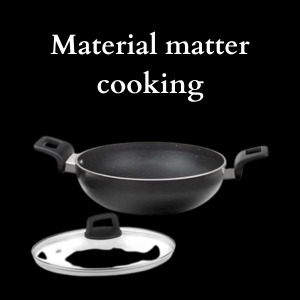
They prioritize using eco-friendly materials and cutting-edge designs to create kitchen tools that enhance cooking experiences while minimizing environmental impact. From non-stick pans to versatile utensils, Material Matter aims to redefine the way we cook and care for our planet.
Stainless Steel: Known for its durability and resistance to staining, stainless steel is versatile and non-reactive. It's ideal for browning, searing, and deglazing. Stainless steel cookware is a popular choice among home chefs and professional cooks alike due to its durability, versatility, and sleek appearance.
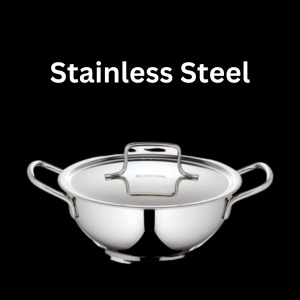
Crafted from an alloy of iron, chromium, and other metals, stainless steel cookware is resistant to rust and staining, making it a long-lasting kitchen staple. Its even heat distribution and non-reactive nature with food make it ideal for a wide range of cooking techniques. In this introduction, we'll explore the benefits and versatility of stainless steel cookware, as well as its maintenance and care to ensure it remains a valuable addition to your kitchen.
Cast Iron: Cast iron cookware retains and distributes heat exceptionally well. It's perfect for slow-cooking, frying, and baking. Seasoning your cast iron adds a natural non-stick surface. Cast iron cookware is a versatile and durable kitchen essential that has been used for centuries. It's made from molten iron that's poured into molds, creating pots, pans, and skillets known for their exceptional heat retention and even heating.
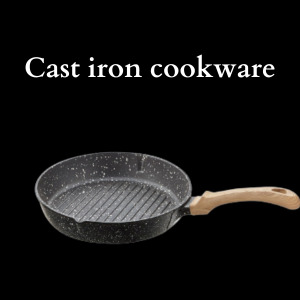
These qualities make cast iron cookware a favorite among professional chefs and home cooks alike. Whether you're searing, frying, baking, or even grilling, cast iron can handle it all. With proper care, it can last a lifetime and develop a natural non-stick surface known as seasoning. Let me know if you'd like to learn more about how to use and maintain cast iron cookware or have specific questions!
Non-Stick: Non-stick cookware has a coating that prevents food from sticking, making it easy to clean. However, it may require gentle care to avoid scratching the surface. Non-stick cookware has revolutionized the way we cook by making food preparation easier and more convenient. These kitchen essentials are typically coated with a non-stick surface, often made from materials like PTFE (Teflon) or ceramic, which prevents food from sticking to the pan.
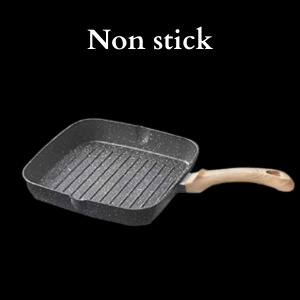
This innovation has reduced the need for excessive oil or butter in cooking, making meals healthier and cleanup a breeze. In this conversation, I can provide you with information, tips, and recommendations related to non-stick cookware
Copper: Copper cookware offers rapid, even heating but often requires a lining of stainless steel or tin to prevent reactivity with certain foods. Copper cookware has a rich culinary history dating back centuries. Renowned for its exceptional heat conductivity, copper cookware offers precise temperature control, making it a favorite among professional chefs and cooking enthusiasts alike. In this guide, we'll explore the benefits, care, and versatility of copper cookware, helping you elevate your culinary skills and create delicious meals.
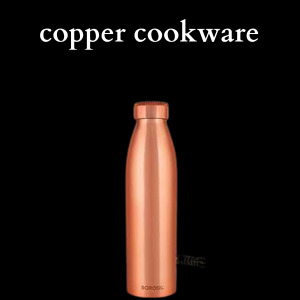
Aluminum: Lightweight and affordable, aluminum cookware heats quickly but may react with acidic foods. Anodized aluminum is a more durable and non-reactive option. Aluminium cookware is a popular choice in kitchens worldwide due to its lightweight, excellent heat conductivity, and affordability. It's commonly used for a wide range of cooking tasks, from sautéing to boiling.
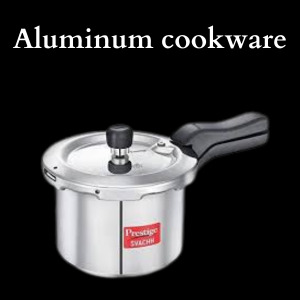
However, it's important to note that uncoated aluminium cookware can react with acidic or alkaline foods, potentially affecting taste and safety. To address this, many aluminium pans have nonstick or anodized coatings. Anodized aluminium is more durable and resistant to corrosion. When choosing aluminium cookware, consider your cooking needs, maintenance preferences, and potential health concerns associated with aluminium exposure.
Choosing the Right Cookware: The cookware you select should align with your cooking style and needs. Here are some considerations. Choosing the right cookware is essential for achieving great results in the kitchen. From pots and pans to utensils and bakeware, selecting the right tools can make cooking more efficient and enjoyable.
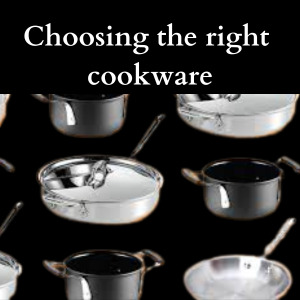
In this guide, we'll explore the key factors to consider when choosing cookware, including material, heat conductivity, durability, and maintenance. Whether you're a seasoned chef or a beginner in the kitchen, making informed choices about your cookware will help you elevate your culinary skills and create delicious meals.
Conclusion :Investing in high-quality cookware is an investment in your culinary journey. By understanding the fundamentals of cookware materials and choosing pieces that align with your cooking style, you'll be well-equipped to create delicious meals for years to come. Remember, the right cookware is not just a tool; it's a partner in your culinary adventures. Happy cooking!
#cookware#kitchen#utensils#home & lifestyle#kitchen appliances#stainless steel#manufacturers#daily update#home cooking#main dishes#alluminum fence#stainless steel kitchen appliances#cooker
2 notes
·
View notes
Text
Top Quality Utensils Manufacturer and Wholesaler in India
Shree Giriraj Udyog is the Best Utensils Manufacturer and wholesaler in INDIA (Jagadhri, Haryana). With years of experience in the industry, we have established ourselves as a trusted and reliable supplier of kitchenware products.

Our Mission
Our mission is to provide our customers with the best products at the most competitive prices. We strive to maintain the highest standards of quality and service, and are committed to building long-term relationships with our clients. Whether you are a small retailer or a large distributor, we have the expertise and resources to meet all your needs. Contact us today to learn more about our products and services.
Our Services and Process
We keep our process fast and simple so our clients face no issue. Our aim is to be more efficient and quick with the client’s request so that the work is delivered on time.
We have attractive services for our clients like:
Bulk Order
Purchase large quantities of utensils at discounted prices and furnish your restaurant or catering business with high-quality and affordable products.

Variety of Brands
Choose from a wide range trusted & known brands to make sure our customers receive the best quality and durability from the products we offer.

Fast Delivery
Get quick and efficient delivery for your bulk orders of utensils, ensuring that you can always keep your restaurant or catering business fully equipped.

Contact and Address:
Mobile: 8708996784, 9729041531
Location: 450, Kalyan Nagar, Jagadhri, Haryana.
Website: https://shreegirirajudyog.com
#Utensils#Utensils Manufacturer#Utensils Wholeseler#Utensils Seller#Kitchen Utensils#Rasoi Utensils#Shree Giriraj Udyog
1 note
·
View note
Text
BLUE ROUND COLANDER.....

https://www.instagram.com/aarshnikhmsteels/
#aarshnikhmsteels#HMSTEELS-AARSHNIK as a leading manufacturer & exporter of Petware#Kitchenware#Barware#Gardening Tools#Furniture#Motorcycle Carriers#AMMO BOX#and Metal Fabricated Products for the last 17 years. We are socially compliant with BSCI; SEDEX/SMETA; SCS; FCCA & ISO 9001:2015.#steel#stainlesssteel#fabrication#colander#kitchenware#kitchen#kitchentools#kitchenutensil#strainer#utensils#householditems#sponge#dmbowl#bowl#kitchenwarehouse#kitchenwareproducts#kitchenware_homeware#housewares
1 note
·
View note
Text
Stainless Steel Kitchen Utensil Set
This is a set of stainless steel cooking tools. Its whole is made of high-quality 304 food grade stainless steel. The handle is hollowed out and bolded.
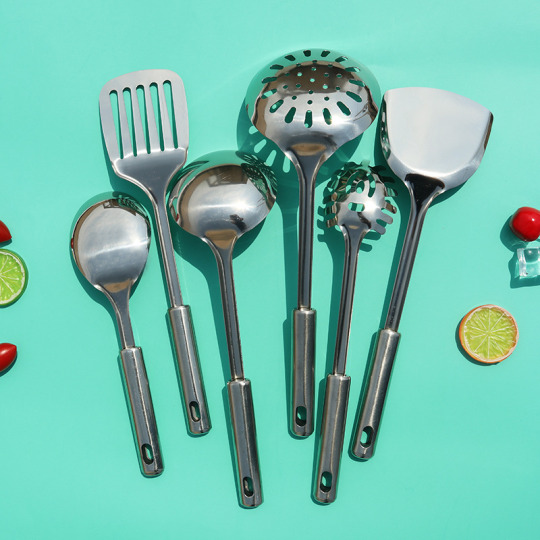
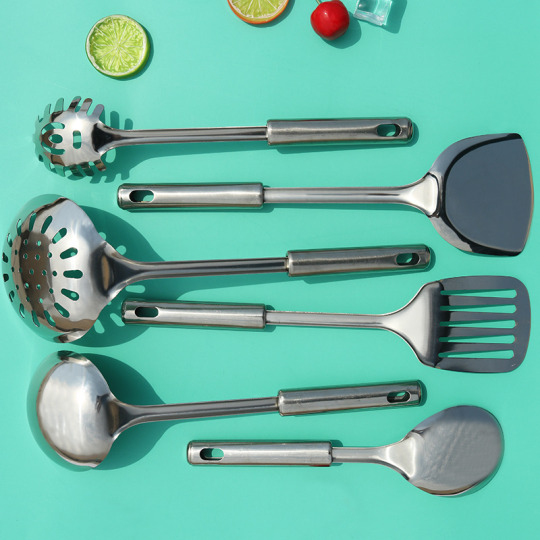

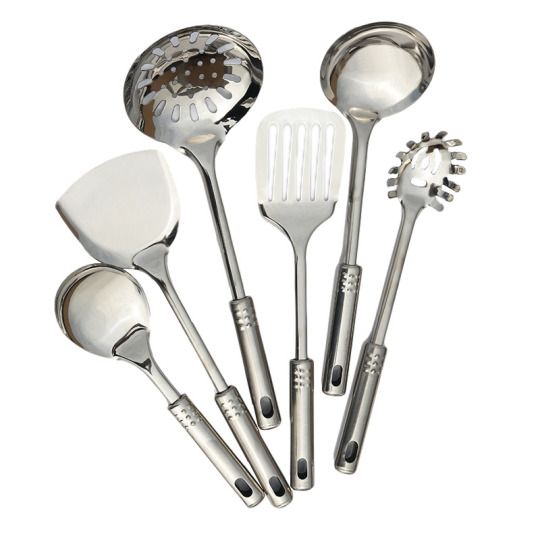
#cookwareset#cookware#cookingtools#kitchenware#kitchenwareproducts#wholesale#manufacturer#stainlesssteel#utensil#utensilset#kitchen#restaurant#manufacturing#wholesalers
0 notes
Text

Hey folks! My name is Dan and I used to work for Tumblr. I quit my job about 10 days ago to prepare and commit myself to a long distance thru hike. Welcome to my hiking Tumblr 🎉🎉🎉
Here we go! It's T minus 4 days until the beginning of my Pacific Crest Trail thru hike. I will be blogging and documenting my journey on the trail. I suppose I will try to publish my posts every time I go into a trail town.
Gear List
Let's break down the gear I will be starting with!
Big 3 (pack, shelter, sleeping bag)
Durston Kakwa 40 - I will be carrying a 40L backpack this time. I've added some patches with fabric glue to personalize it a little bit (◕‿◕✿)
Enlightened Equiptment Enigma 20F Quilt
Durston Gears X-Mid Pro 1 - best lightweight trekking pole tents imo
Sleeping Pad - Klymit Insulated V UL SL
Water Filtration
Smart Water Bottle 1L x 4
Sawyer Squeeze <3
Kitchen
Jetboil Stash
Fuel Cannister
Utensils
Bic lighter
Toiletries
Nail Clipper
Wet Wipes
Toothbrush/Toothpaste
Sunscreen
Chafing Balm
Trowel
Lip Balm
First Aid Kit/Duct Tape/Meds
Clothing
Smart Wool Socks x 2
Arcteryx Synthetic
Arcteryx Atom Shell
Patagonia Wind Pants
Leggings
Baseball Cap
Underwear x 2
Hiking Shorts
Patagonia Sun Hoodie
T-shirt x 2
STUFF
Apple EarPods
iPhone 11 Pro
Garmin Inreach Mini 2 - satellite transmitter
Nitecore UL Headlamp
Nitecore UL 10000 mAh Powerbank x 2
Sony ZV-1 & UL tripod
Journal & Pen
UL Sea2Summit Pillow
Bug Net
Microspikes
There may be a few I'm leaving out of this list but ^ gives you a general sense of what I will be carrying. Here's also a link to my lighter pack
Base weight is currently just under 14 lbs! As reference, I am 5'7 130 lbs
Section 1: Southern California
The Southern Californian portion of the trail is dominated by desert landscapes with a few mountain passes. Socal saw record snow fall this year so I hope water resupply in this section won't be as big of an issue!
The following are all the trail towns I will be visiting in this section. For the sake of simplicity, all trail towns up to Kennedy Meadows South or KMS will be part of socal.

My friends back in NYC will be sending me resupply packages as I go. Currently, I'm reading Pacific Crest Trials which I am finding to be very interesting in terms of mental preparation for the thru hike.
My friend Kevin will be driving me down to Campo, the southern terminus of the trail on the 29th!

I'm feeling pretty good about this and as prepared as I can be!!! I also reached out to a manufacturer to make pins I could give out to fellow hikers on the trail. I've learned from music festivals that pins are a great way to make friends :3
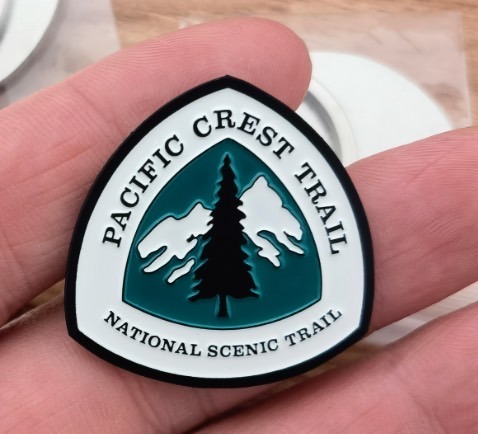
It's just a simple design of the PCT trail marker but it came out looking very nice!
Intentions & Goals
I read this book called 'Start With Why' with one of my previous coworker and I thought defining my "why"s for the trail will help tremendously. I know I will have really tough days and days when I want to just quit and go back to the comforts of society. Here is my unpolished "why" for the PCT that I memoed on my phone:
I am doing this for to remind myself that I can do anything I put my mind to. This year, my friend passed away and I was reminded that life is fleeting and I need to live pursuing what I want more vigorously. Postponing happiness until retirement is a flawed life approach! I've always wanted to this and I would like to take this time to figure out what I really want to do in this life and where I want to end up. I am trying to live with more intentionality and I'm working towards a real goal I've set for myself and doing this out of my own joy.
I am hiking the PCT because:
I need time to evaluate what I want to do with my life and career
The PCT has always been a larger than life adventure that I wanted to do
Life is short and I should take every chance I get to pursue what I want to do in life
I have the rest of my life to excel in my career
I want to experience true freedom and self sufficiency
I want to prove to myself I can do anything I set my mind to
Well here we go and I will try to post updates on my epic as I go :D
Happy Earth month! Go plant a tree 🌲
50 notes
·
View notes
Text
Sleek and Stylish: A Modular Kitchen Transformation
Are you dreaming of a kitchen that's not only functional but also visually appealing? Look no further than the modular kitchen revolution! These customizable spaces offer a world of possibilities, allowing you to create a kitchen that perfectly suits your style and needs.
What is a Modular Kitchen?
Modular kitchens are prefabricated units that can be combined in various configurations to create a unique and personalized space. Unlike traditional kitchens, where cabinets and appliances are installed individually, modular kitchens come as ready-to-assemble components that can be easily installed.
Benefits of Modular Kitchens
Customization: Modular kitchens offer unparalleled customization options. You can choose from a wide range of colors, finishes, and materials to create a kitchen that reflects your personal style. From sleek and minimalist to warm and traditional, there's a modular kitchen design for everyone.
Efficiency: Modular kitchens are designed for maximum efficiency. The cabinets and appliances are arranged in a way that maximizes storage space and workflow. This means you can spend less time searching for items and more time enjoying your cooking.
Durability: Modular kitchens are built to last. The materials used are high-quality and resistant to wear and tear. With proper care, your modular kitchen can provide years of enjoyment.
Easy Installation: Modular kitchens are relatively easy to install compared to traditional kitchens. The components are designed to fit together seamlessly, and many manufacturers offer professional installation services.
Cost-Effective: While modular kitchens may have a higher upfront cost than traditional kitchens, they can be more cost-effective in the long run. The modular design allows for easier repairs and replacements, reducing maintenance costs.
Designing Your Dream Modular Kitchen
When designing your modular kitchen, consider the following factors:
Layout: Choose a layout that best suits your needs and the available space. Popular options include U-shaped, L-shaped, and straight-line kitchens.
Storage: Think about your storage needs and choose cabinets and drawers that can accommodate your cookware, utensils, and appliances.
Appliances: Select appliances that match your cooking style and complement the overall design of your kitchen.
Worktops: Choose a durable and stylish worktop material, such as granite, quartz, or laminate.
Lighting: Adequate lighting is essential for a functional and visually appealing kitchen. Consider both overhead lighting and task lighting for specific areas.
A Stunning Modular Kitchen
The kitchen pictured above is a beautiful example of a modular kitchen design. The bold red cabinets create a striking focal point, while the white countertops and backsplash provide a clean and modern contrast. The ample storage space and well-designed layout make this kitchen both functional and stylish.
Conclusion
Modular kitchens offer a versatile and customizable solution for creating your dream kitchen. With their efficiency, durability, and ease of installation, it's no wonder that modular kitchens are becoming increasingly popular. So, if you're ready to transform your kitchen space, consider the endless possibilities offered by modular design.

#decor#interiorstyling#furniture#interiordesign#home interior#furnituredesign#home design#home decor#homedecor#interiordecor#upvc profiles#upvcdoors#upvc sliding doors#modularkitcen
2 notes
·
View notes
Text

What is main things to clean a kitchen?
Keeping your kitchen clean is essential for maintaining a healthy and pleasant cooking environment. Regular cleaning not only ensures that your kitchen remains hygienic but also helps prevent the buildup of grime, which can lead to unpleasant odors and potential health hazards. To efficiently clean your kitchen, it's important to focus on several key areas and use the right tools and techniques. This guide will walk you through the main tasks involved in kitchen cleaning, offering tips and answering common questions to help you maintain a spotless kitchen.
What is the Necessary Things You Need In The Kitchen
Counters and Surfaces: Start by clearing off all countertops, including any small appliances, utensils, and food items. Use a kitchen cleaner or a mix of mild soap and water to wipe down surfaces. Pay attention to areas around the sink, stove, and backsplash where spills and splatters can accumulate.
Sink: The sink often harbors bacteria and food particles. Scrub the sink with a non-abrasive cleaner or a mixture of baking soda and water. For a sparkling finish, you can also use a solution of vinegar and water. Don’t forget to clean the faucet and handles, as these are frequently touched areas.
Stovetop: Remove burner grates and knobs if you have a gas stove. Soak them in soapy water and scrub away any grease or residue. For electric stoves, wipe down the surface with a suitable cleaner, ensuring you don’t use excessive moisture that could damage electrical components.
Oven: Clean the interior of the oven periodically to avoid the buildup of burnt food and grease. Use an oven cleaner or a homemade paste of baking soda and water. For self-cleaning ovens, follow the manufacturer’s instructions to activate the cleaning cycle.
Refrigerator: Empty the refrigerator and discard any expired or unwanted food. Wipe down shelves and drawers with a mixture of water and mild detergent. Clean the exterior and handles with an all-purpose cleaner.
Flooring: Sweep or vacuum the kitchen floor to remove crumbs and debris. Mop the floor using a cleaner suitable for your flooring type (tile, laminate, etc.). Make sure to rinse the mop frequently to avoid spreading dirt around.
Garbage and Recycling: Regularly empty the trash and recycling bins to prevent odors and bacterial growth. Clean the bins themselves with soap and water to remove any residual grime.
Small Appliances: Wipe down small appliances like toasters, microwaves, and coffee makers. For appliances with removable parts, such as toaster trays or microwave turntables, wash them separately.
Frequently Asked Question
How often should I clean my kitchen?
It’s best to do a quick clean daily—wipe down surfaces, wash dishes, and sweep the floor. A more thorough cleaning should be done weekly, including scrubbing the sink, stovetop, and refrigerator. Monthly or quarterly, address deep cleaning tasks like oven cleaning and organizing cabinets.
What’s the best way to clean greasy kitchen cabinets?
To clean greasy cabinets, use a mixture of warm water and dish soap. For stubborn grease, add a bit of baking soda to the solution. Apply with a soft cloth or sponge, and wipe with a clean, damp cloth to remove any soap residue.
How do I get rid of odors in my garbage disposal?
To eliminate odors, grind up lemon peels or ice cubes in the disposal. You can also use a mixture of baking soda and vinegar, letting it sit for a few minutes before running water through the disposal.
Can I use bleach to clean my kitchen?
While bleach is effective for disinfecting, it’s often too harsh for regular kitchen cleaning. Use it sparingly and always dilute it according to the manufacturer’s instructions. For routine cleaning, stick to milder cleaners to avoid damaging surfaces.
What’s the best way to clean stainless steel appliances?
To clean stainless steel appliances, use a dedicated stainless steel cleaner or a mixture of water and vinegar. Wipe in the direction of the grain and dry with a soft cloth to avoid streaks and water spots.
Conclusion
A clean kitchen is the cornerstone of a healthy and enjoyable cooking experience. By regularly addressing key areas such as countertops, sinks, stovetops, and floors, and utilizing the right cleaning tools and techniques, you can maintain a space that is not only visually appealing but also hygienic. Remember that consistency is key—daily tidying, weekly deep cleaning, and periodic maintenance will keep your kitchen in top shape. By incorporating these practices into your routine and addressing common questions and concerns, you'll ensure that your kitchen remains a safe, efficient, and pleasant place to prepare meals. Happy cleaning!
2 notes
·
View notes
Text
Household Appliances Market Overview: Growth Factors and Future Trends (2023-2032)
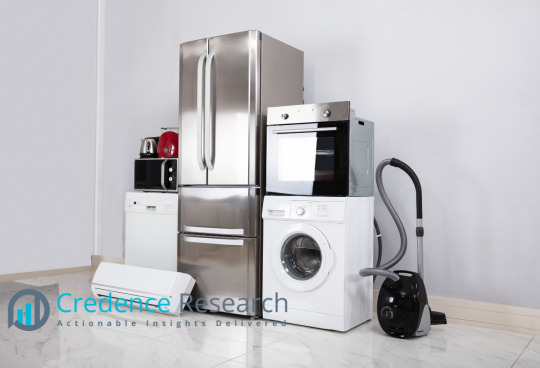
The global demand for Household Appliances was valued at USD 602514.2 million in 2023 and is expected to reach USD 1035351.78 million in 2032, growing at a CAGR of 6.20% between 2024 and 2032.
The household appliances market encompasses a wide range of devices and equipment used for everyday domestic tasks such as cooking, cleaning, and food preservation. This market includes major appliances like refrigerators, washing machines, dishwashers, ovens, and air conditioners, as well as small appliances such as microwaves, vacuum cleaners, coffee makers, and blenders. The growth of this market is driven by factors such as increasing urbanization, rising disposable incomes, and technological advancements that enhance convenience and efficiency.
Consumers are increasingly seeking smart appliances with features like energy efficiency, connectivity, and automation, which allow for better control and monitoring of household tasks. Additionally, the trend towards sustainable living is leading to a higher demand for eco-friendly and energy-efficient appliances. Key players in the market, such as Whirlpool, Samsung, LG, and Electrolux, continually innovate to meet evolving consumer preferences and regulatory standards. The household appliances market is highly competitive and global, with significant growth potential in emerging economies where rising living standards and expanding middle classes are driving demand for modern home conveniences.
Major Household Appliances-
Refrigerators: Used for preserving food by keeping it cold.
Washing Machines: Used for cleaning clothes automatically.
Dishwashers: Used for cleaning dishes and utensils.
Ovens: Used for baking, roasting, and cooking food.
Air Conditioners: Used for cooling and sometimes heating indoor air.
Microwaves: Used for quick cooking, heating, and defrosting food.
Dryers: Used for drying clothes after washing.
Small Appliances-
Vacuum Cleaners: Used for cleaning floors, carpets, and upholstery.
Coffee Makers: Used for brewing coffee.
Blenders: Used for blending, mixing, and pureeing food and drinks.
Toasters and Toaster Ovens: Used for toasting bread and baking small items.
Electric Kettles: Used for boiling water quickly.
Irons: Used for removing wrinkles from clothes.
Food Processors: Used for chopping, slicing, and dicing food.
Kitchen Appliances-
Stoves and Cooktops: Used for cooking food using gas or electricity.
Slow Cookers: Used for cooking food at low temperatures over a long period.
Pressure Cookers: Used for cooking food quickly under high pressure.
Rice Cookers: Used for cooking rice perfectly and sometimes other grains.
Juicers: Used for extracting juice from fruits and vegetables.
Cleaning Appliances-
Steam Mops: Used for deep cleaning floors with steam.
Robotic Vacuum Cleaners: Automated devices used for cleaning floors without manual intervention.
Carpet Cleaners: Used for deep cleaning carpets.
Personal Care Appliances-
Hair Dryers: Used for drying hair quickly.
Electric Shavers: Used for shaving facial or body hair.
Hair Straighteners: Used for straightening hair.
Home Comfort Appliances-
Humidifiers: Used for adding moisture to the air.
Dehumidifiers: Used for removing moisture from the air.
Heaters: Used for providing warmth during cold weather.
Fans: Used for circulating air and providing cooling.
Health and Wellness Appliances-
Air Purifiers: Used for cleaning the air of pollutants and allergens.
Water Purifiers: Used for making drinking water safe and clean.
Electric Massagers: Used for relieving muscle tension and pain.
Household Appliances Market Challenges:
Intense Competition-
Market Saturation: The household appliances market is highly competitive, with numerous established brands and new entrants constantly vying for market share.
Price Wars: Intense competition often leads to price wars, which can erode profit margins for manufacturers and retailers.
Technological Advancements-
Rapid Innovation: The fast pace of technological advancements requires companies to continually invest in research and development to stay relevant and competitive.
Obsolescence: Products can quickly become outdated, forcing companies to regularly update their offerings, which can be costly.
Supply Chain Disruptions-
Global Dependencies: The global nature of the supply chain makes it vulnerable to disruptions caused by geopolitical tensions, natural disasters, and pandemics.
Logistics Issues: Shipping delays and increased transportation costs can impact the timely delivery of products and overall profitability.
Regulatory Compliance-
Environmental Regulations: Increasingly stringent environmental regulations require manufacturers to produce energy-efficient and eco-friendly products, which can increase production costs.
Safety Standards: Adhering to various safety standards across different regions can be complex and expensive.
Sustainability Concerns-
Eco-Friendly Materials: The demand for sustainable and recyclable materials poses a challenge, as they can be more expensive and harder to source.
Waste Management: Managing electronic waste and ensuring proper disposal or recycling of old appliances is a growing concern.
Consumer Expectations-
Quality and Reliability: Consumers expect high-quality, reliable products, and any failure can lead to loss of brand reputation and customer loyalty.
Smart Features: Increasing demand for smart and connected appliances requires significant investment in technology and infrastructure.
Economic Fluctuations-
Recession Impact: Economic downturns can lead to reduced consumer spending on non-essential items, including household appliances.
Currency Fluctuations: Exchange rate volatility can affect the cost of imported components and overall pricing strategies.
Key Players:
Dick GmbH & Co (Germany)
GLOBAL APPLIANCES USA (U.S.)
KAI USA LTD (U.S.)
Kiya corp. (Japan)
A.C. Knife (U.S.)
Messermeister (Germany)
Victorinox AG (Switzerland)
Anker Innovation Technology Co., Ltd. (China)
Samsung Electronics Co., Ltd (South Korea)
Shenzhen Proscenic Technology Co. Ltd. (China)
Neato Robotics, Inc. (U.S.)
Cecotec Innovaciones S.L. (Spain)
G. Electronics Inc (South Korea)
Dyson Limited (U.K.)
Panasonic Corporation (Japan)
Sharp Corporation (U.S.)
More About Report- https://www.credenceresearch.com/report/household-appliances-market
The household appliances market is influenced by a variety of dynamic factors that shape its growth, trends, and competitive landscape. Understanding these dynamics is crucial for market players to navigate the industry effectively. Here are the key dynamics:
Consumer Preferences and Behavior:
Smart and Connected Appliances: There is a growing preference for smart appliances that offer remote control, automation, and connectivity with other smart home devices.
Energy Efficiency: Consumers are increasingly seeking energy-efficient appliances to reduce electricity bills and minimize environmental impact.
Aesthetic and Design: Stylish and aesthetically pleasing designs are becoming important as consumers look for appliances that complement their home decor.
Convenience and Ease of Use: Features that enhance convenience and ease of use, such as touch controls, voice commands, and self-cleaning functions, are highly valued.
Technological Trends:
Internet of Things (IoT): Integration of IoT technology in appliances allows for smart functionality, remote monitoring, and control, leading to improved user experience.
Artificial Intelligence (AI): AI-driven appliances offer advanced features like predictive maintenance, personalized settings, and enhanced performance.
Sustainability Innovations: Development of eco-friendly appliances using sustainable materials and technologies to reduce energy and water consumption.
Competitive Landscape:
Major Players: Dominated by global giants such as Whirlpool, Samsung, LG, Electrolux, and Bosch, which continuously innovate and expand their product portfolios.
Local Brands: In emerging markets, local brands compete effectively by offering cost-effective solutions tailored to regional preferences.
Mergers and Acquisitions: Companies engage in mergers, acquisitions, and strategic partnerships to expand their market presence and technological capabilities.
Regulatory and Environmental Factors:
Energy Regulations: Governments worldwide are implementing stringent energy efficiency standards, compelling manufacturers to produce compliant appliances.
Environmental Policies: Policies promoting the reduction of carbon footprints and the use of eco-friendly materials influence product development and manufacturing processes.
Safety Standards: Compliance with safety regulations is crucial to ensure consumer safety and avoid legal repercussions.
Economic Influences:
Economic Stability: Economic conditions significantly impact consumer spending on household appliances. Economic downturns can lead to reduced demand, while periods of growth boost sales.
Currency Fluctuations: Exchange rate volatility affects the cost of imported components and final product pricing, influencing profitability.
Supply Chain Dynamics:
Global Supply Chain: The globalized supply chain for components and raw materials can be vulnerable to disruptions caused by geopolitical tensions, natural disasters, and pandemics.
Logistics and Distribution: Efficient logistics and distribution networks are essential to ensure timely delivery and availability of products in various markets.
Marketing and Branding:
Brand Loyalty: Strong brand recognition and loyalty play a crucial role in consumer purchasing decisions. Established brands invest heavily in marketing to maintain their market position.
Digital Marketing: The rise of digital marketing, social media, and influencer collaborations enhances brand visibility and consumer engagement.
E-commerce and Retail Trends:
Online Sales Growth: The shift towards online shopping, accelerated by the COVID-19 pandemic, has led to increased sales through e-commerce platforms.
Omni-channel Strategies: Companies are adopting omni-channel retail strategies, integrating online and offline sales channels to provide a seamless shopping experience.
Segmentation:
By Major Appliance Segmentation:
Refrigerators and Freezers
Cooking Ranges and Ovens
Dishwashers
Range Hoods and Ventilation Systems
Food Processors and Blenders
Laundry Appliances:
Washing Machines
Clothes Dryers
Washer-Dryer Combos
Ironing Systems
Water Heaters and Boilers
Air Conditioners and Heaters
Browse the full report – https://www.credenceresearch.com/report/household-appliances-market
Browse Our Blog: https://www.linkedin.com/pulse/household-appliances-market-analysis-global-industry-qqiif
Contact Us:
Phone: +91 6232 49 3207
Email: [email protected]
Website: https://www.credenceresearch.com
2 notes
·
View notes
Text
Top-Quality Spoons Manufacturers
At Royal Kitchenware, we are committed to providing the highest quality Spoon Manufacturers in the industry. We offer a wide range of spoon styles, including serving spoons, soup spoons, dessert spoons, and more.
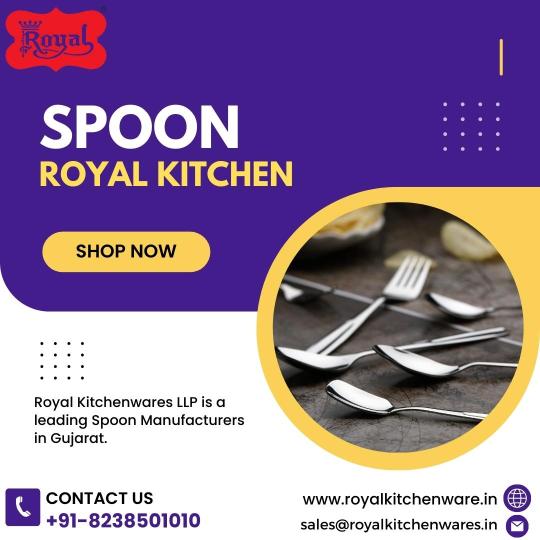
#Spoon Manufacturers#Spoon Makers#Handmade Spoons#Custom Spoons#Wooden Spoons#Metal Spoons#Kitchen Utensils#Table ware#Eco Friendly Spoons#Sustainable Spoons#Healthy Eating#Home Cooking#Cooking Tools
0 notes
Text
What do everyday objects look like in Sci Fi settings?
Ask Box
Something I see a lot in sci-fi beginner projects is no variation in the evolution of everyday objects. A lot of things simply look exactly the same as they do now.
This youtube video got me thinking about th ergonomics of futuristic objects.
That being said,
What do kitchen utensils look like for the aliens in your future setting?
What of writing utensils?
How have everyday objects evolved as new manufacturing techniques have evolved?
What things stayed the same for humans?
Are there things aliens adopted from humans? How about vice versa?
If you'd like second thoughts on your thoughts my ask box is always open!
#worldbuilding#writing#world building#worldbuilding beginner#sciencefiction#scifi#sci fi#science fiction
7 notes
·
View notes
Text
How do you clean and maintain a frying pan to extend its lifespan?
A frying pan is a steadfast companion in the kitchen, witnessing the sizzles and aromas of countless meals. To ensure it remains a reliable culinary ally, proper cleaning and maintenance are essential. In this comprehensive guide, we'll explore the steps and tips for cleaning and maintaining a frying pan, unveiling the secrets to extending its lifespan and preserving its performance.
Cleaning Your Frying Pan
Immediate Post-Cooking Care: Strike While It's HotThe key to easy cleaning is addressing the frying pan immediately after use. Allow it to cool slightly, but not completely, before cleaning. This is especially crucial for cast iron pans, as cleaning them while warm facilitates the removal of food residues.
Avoid Cold Water Shocks: Gradual Temperature ChangesRapid temperature changes can damage your frying pan, especially if it's made of materials like cast iron. Avoid shocking the pan with cold water immediately after cooking, as this can lead to warping. Instead, let it cool gradually to room temperature before beginning the cleaning process.
Hand Wash with Mild Soap: Gentle CleansingFor most frying pans, hand washing is recommended to preserve their integrity. Use a mild dish soap and a soft sponge or brush to clean the pan. Avoid harsh scrubbers or abrasive pads, as they can damage non-stick coatings and remove the seasoning from cast iron pans.
Hot Water Soak for Stubborn Residues: Loosening Stuck-On FoodIf there are stubborn residues clinging to the pan, a hot water soak can work wonders. Fill the pan with hot water and let it sit for 15-30 minutes. The heat will help loosen food particles, making them easier to scrub off. After soaking, use a gentle brush or sponge to clean the pan.
Baking Soda and Vinegar for Tough Stains: Natural Cleaning AgentsFor particularly stubborn stains or burnt-on food, create a paste using baking soda and water. Apply the paste to the affected areas and let it sit for about 15 minutes. The baking soda helps to lift stains and residues. Afterward, use a soft brush or sponge to scrub the pan. Alternatively, vinegar can be used to tackle stains and add shine. Remember to rinse thoroughly after using baking soda or vinegar.
Avoid Dishwashers for Non-Stick Pans: Gentle TreatmentWhile some frying pans may be labeled as dishwasher-safe, it's generally advisable to hand wash non-stick pans. The harsh detergents and high heat in dishwashers can degrade the non-stick coating over time. Follow the manufacturer's recommendations for the best care.
Removing Rust from Cast Iron: Restoring SeasoningIf you're dealing with a cast iron pan and notice signs of rust, don't panic. Rust can be removed, and the seasoning restored. Scrub the rusted areas with steel wool or a stiff brush until the rust is gone. Afterward, re-season the pan by applying a thin layer of oil and baking it in the oven. This process helps protect the pan and enhances its non-stick properties.
Dry Immediately: Warding Off RustAfter cleaning, ensure the frying pan is thoroughly dried to prevent rust. Use a kitchen towel to remove excess moisture, and if needed, place the pan on low heat on the stove for a few minutes to evaporate any remaining water. Proper drying is especially crucial for cast iron and carbon steel pans.
Maintaining Your Frying Pan
Season Cast Iron Pans Regularly: A Protective LayerCast iron pans develop a natural non-stick surface through a process called seasoning. To maintain this protective layer, season your cast iron pan regularly. After cleaning, apply a thin layer of oil to the pan and bake it in the oven according to the manufacturer's instructions.
Avoid Metal Utensils: Preserving CoatingsWhen cooking with non-stick pans, use wooden, silicone, or plastic utensils to avoid scratching the coating. Metal utensils can compromise the integrity of the non-stick surface, reducing its effectiveness over time.
Store Pans Properly: Preventing DamageHow you store your frying pans can impact their longevity. Avoid stacking pans directly on top of each other, especially if they have non-stick coatings. Place a protective layer, such as a soft cloth or paper towel, between stacked pans to prevent scratches and damage.
Re-Season Cast Iron as Needed: Monitoring PerformanceOver time, the seasoning on cast iron pans may wear off with regular use. If you notice a decline in the non-stick properties or see signs of rust, it's time to re-season the pan. This process helps maintain the pan's performance and protects it from corrosion.
Check and Tighten Handles: Ensuring StabilityPeriodically check the handles of your frying pans for any wobbling or looseness. If handles become loose, tighten the screws or bolts as needed. This simple maintenance step helps ensure the stability and safety of your pans.
Use the Right Cooking Utensils: Preventing ScratchesBe mindful of the utensils you use while cooking. Using metal utensils on non-stick surfaces can cause scratches and reduce the effectiveness of the coating. Opt for softer utensils to preserve the integrity of the pan.
Avoid High Heat for Non-Stick Pans: Prolonging Coating LifeNon-stick pans have temperature limits, and exposing them to high heat can lead to the breakdown of the coating. Avoid using non-stick pans on high heat settings, and opt for medium to low heat for best results.
Regularly Check for Wear and Tear: Proactive MaintenanceKeep a watchful eye on your frying pans for any signs of wear and tear. If you notice chips, scratches, or a decline in performance, address the issues promptly. Proactive maintenance ensures that small problems don't escalate into more significant concerns.
Conclusion
A well-maintained frying pan is the cornerstone of a functional and enjoyable kitchen. By following these cleaning and maintenance tips, you can extend the lifespan of your frying pan, preserving its performance and ensuring it continues to be a reliable partner in your culinary adventures. Whether you're dealing with cast iron, stainless steel, or non-stick pans, the key is to treat them with care, address issues promptly, and appreciate the longevity they bring to your kitchen. With proper care and attention, your frying pan can withstand the test of time, contributing to countless delicious meals and memories.
2 notes
·
View notes
Text
Unlocking the Power of Silicon Manganese: Sarda Metals

Silicon manganese is a critical alloy used in various industries, each benefiting from its unique properties and versatility. Sarda Metals, a renowned producer and leading metals manufacturer in India, has been at the forefront of supplying high-quality silicon manganese for countless applications. In this article, we explore the diverse areas where silicon manganese makes a significant impact.
Electronics: Powering the Digital World
Silicon manganese is a key ingredient in the world of electronics. Its exceptional conductivity and durability make it an ideal component for semiconductors, transistors, and integrated circuits. These tiny yet powerful devices are the backbone of our digital world, driving everything from smartphones to computers.
Solar Panels: Harnessing Clean Energy
The renewable energy sector relies on silicon manganese for the production of solar panels. These panels use silicon as a semiconductor to convert sunlight into electricity efficiently. As the world shifts toward sustainable energy sources, silicon manganese plays a pivotal role in supporting this transition.
Construction: Building for the Future
In the construction industry, silicon manganese is used in high-strength materials such as silicones and sealants. These materials provide durability and weather resistance, making them invaluable for sealing structures against the elements.
Medical Devices: Precision and Biocompatibility
Silicon manganese-derived silicones find applications in the medical field. They are used in the production of biocompatible medical implants, such as breast implants and catheters, due to their non-reactive nature and flexibility.
Automotive Industry: Driving Innovation
The automotive sector benefits from silicon manganese in various components, including sensors, engine control units (ECUs), and tire pressure monitoring systems (TPMS). These components enhance vehicle performance, safety, and efficiency.
Aerospace: Soaring to New Heights
Silicon manganese-based materials are essential in aerospace applications, thanks to their lightweight and high-temperature resistance. They contribute to the construction of aircraft components and spacecraft, ensuring safe and efficient travel beyond our atmosphere.
Kitchenware: Enhancing Culinary Experiences
In the kitchen, silicon manganese-derived silicones are used to create non-stick cookware, baking molds, and kitchen utensils. Their heat resistance and non-reactive properties make cooking a breeze.
Glass Industry: A Clear Choice
Silicon dioxide (silica), derived from silicon, is a fundamental component in the glass manufacturing process. It enhances the transparency, strength, and heat resistance of glass products.
Chemical Industry: Catalyzing Innovation
Silicon compounds play a pivotal role in various chemical processes, acting as catalysts that drive the production of a wide array of products, ranging from plastics to pharmaceuticals.
But let's delve deeper into the world of silicon manganese, expertly manufactured by the industry leader, Sarda Metals, a renowned metals manufacturer in India. It's more than just an alloy; it stands as a catalyst for progress and innovation across a multitude of sectors. As we forge ahead in the realms of technology and environmental sustainability, silicon manganese emerges as a critical player in shaping our future.
Silicon manganese isn't merely an alloy—it's the very foundation upon which countless innovations are built. Join us in recognizing its profound significance as we strive to construct a brighter and more sustainable future together.
🏠 Address: 50-96-4/1, 2nd & 3rd Floor, Sri Gowri Nilayam, Seethammadhara NE, Visakhapatnam, Andhra Pradesh, 530013 - India.
📞 Phone: 9493549632
📧 Email: [email protected]
#SiliconManganese#SardaMetals#Metallurgy#Alloys#SteelProduction#IndustrialMaterials#Mining#MetalIndustry#RawMaterials#Manufacturing#Steel#Metals#Production#ManganeseAlloy#QualityMaterials#SustainableIndustry
3 notes
·
View notes
Text
SKY BLUE PYRAMID COLANDER
HMSTEELS-AARSHNIK as a leading manufacturer & exporter of Petware, Kitchenware, Barware, Gardening Tools, Furniture, Motorcycle Carriers, AMMO BOX, and Metal Fabricated Products for the last 17 years. We are socially compliant with BSCI; SEDEX/SMETA; SCS; FCCA & ISO 9001:2015.
https://www.instagram.com/aarshnikhmsteels/
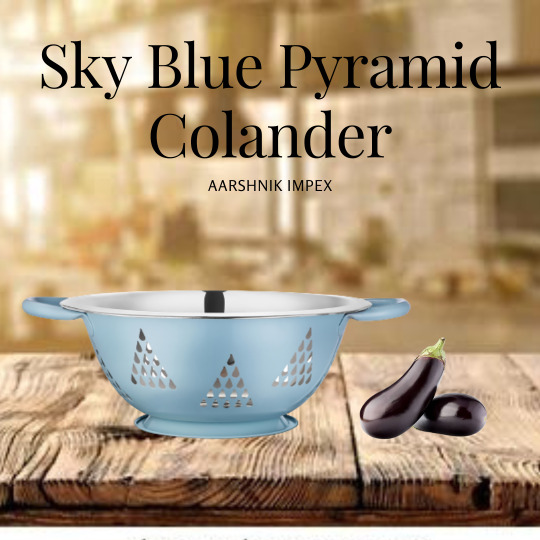
#steel #stainlesssteel #fabrication #colander #kitchenware #kitchen #kitchentools #kitchenutensil #strainer #utensils #householditems #sponge #kitchen #dmbowl #bowl #kitchenwarehouse #kitchenwareproducts #kitchenware_homeware #housewares
2 notes
·
View notes
Text
I'd also want to add that "new things" does not translate to "brand new" necessarily, as you start to slowly notice that so much of the "affordable brand new" things are quick to break, quick to peel off, quick to stain, quick to fall apart...
You'll find yourself irritated at the instability of your Ikea bookshelves and how quickly the wood pulp sucks up moisture and dies out, you'll find yourself inconvenienced by the cheap kitchen table whose screws you have to tighten every week or it'll wobble and creak loudly every meal, you'll find yourself miserable with how quickly the pleather peels off your 1yo Forever 21 jacket, how easily the soles of your 6mo shoes wear; and you slowly start to realize that there's a reason the old old old solid wood china cabinet from your grandma's house has been in the family for generations, there's a reason your dad has worn the same leather jacket since you were a kid, there's a reason your mom's winter boots have lasted through a decade of blizzards.
So you stop looking for the "brand new, just manufactured by a child slave in a sweatshop in Thailand" kind of things, and instead you look for the "new to you, but was loved by many before" kind of things. You patch up the small tear of a thrift store leather jacket to give it another 15y of chance to thrive, you find a $50 solid wood cabinet with its original brass handles and peppered with scratches that show decades of love from a whole family that can't keep it anymore, and you give your mother's old shoes a good polish and maybe a small mend to give them the chance to keep another generation safe from the bite of the cold.
You start looking for well loved furniture, clothing, books, picture frames, kitchen utensils that lasted for so long under so many hands for a reason, that you just need to maybe mend a little or deep clean a bit, but that you know will look brand new for another decade at least. Things you'll pay 10 dollars for not to be frugal, but because their previous owners know how few people in this world value the things that withstood the trials of time versus the ones that you can bring home untouched, in a branded box or fancy paper bag. But you know, you've started noticing already �� some of the nice things, the things that will last most of the rest of your life, have already lasted most of someone else's life
I'm turning 30 this month, and for some reason have become suddenly interested in material possessions. like what if,,,,,,,,my couch was nice. what if my sheets were nice. is this what happens to you??
#ok but this is EXTREMELY REAL#pls get second hand stuff when u can#i say that as someone who is going through that stage in my life
46K notes
·
View notes
Text
Kitchen cabinets Hollywood FL

Starting a kitchen remodel is an exciting project that can transform your home into a stylish and functional space. Whether you're looking for custom kitchen cabinets in Hollywood, exploring options for kitchen cabinets in Wilton Manors, or visiting a kitchen cabinets shop in Hollywood, it's essential to balance your budget by investing in key features while finding smart ways to save.
In this blog post, we’ll guide you through the remodeling process, helping you decide where to spend and where to save. Whether you're upgrading kitchen cabinets in Lighthouse Point or searching for kitchen cabinets in Hollywood, FL, we have the insights to make your project a success.
Where to Splurge:
1. Quality Cabinets:
Top kitchen cabinet choices are essential for every kitchen, combining durability and style. Selecting top cabinets for kitchen spaces ensures both functionality and a polished look. If you're aiming for luxurious kitchen cabinets, consider options like Lily Ann Cabinets, crafted from solid wood or plywood, featuring soft-close hinges and full-extension drawers for enhanced usability.
Visit a cabinet kitchenstore to explore two-tone cabinet kitchens, a trendy design that adds depth and contrast to your space. If you're searching for custom-made cabinets near me, Lily Ann Cabinets offers high-quality craftsmanship at an affordable price, built to withstand everyday use.
2. Countertops:
Countertops take a lot of wear and tear from everyday kitchen use. Investing in strong and attractive materials such as granite, quartz, or marble can enhance the overall appearance of your kitchen. These materials are also long-lasting, making them a smart choice.
3. Appliances:
Buying energy-efficient and high-performance appliances is a smart choice. Stainless steel appliances are stylish and durable. Think about choosing brands that are reliable and use the latest technology, so your kitchen remains modern and efficient for a long time.
4. Lighting:
Good lighting can change the feel of your kitchen. Adding pendant lights above the island, installing under-cabinet lights, and choosing eye-catching fixtures over the dining space are great ways to invest a bit more. These improvements boost both usefulness and style.
5. Flooring:
The kitchen floor gets a lot of use, with many people walking on it, spills happening, and utensils falling. It's important to choose strong, long-lasting flooring materials like porcelain tile, hardwood, or engineered wood for durability and easy care.
Where to Save:
1. Backsplash:
A nice backsplash can make your kitchen look great without costing too much. Look into affordable choices like ceramic subway tiles or peel-and-stick backsplashes for a stylish and budget-friendly option.
2. Hardware:
Cabinet handles, knobs, and faucets offer budget-friendly choices that still look stylish. You can find many modern and attractive designs at good prices, helping you save money while keeping a nice appearance.
3. Open Shelving:
Try using open shelving instead of custom cabinets. It's a popular trend in kitchen design and is cheaper than adding more cabinets. Showing off nice dishes and cookware can give your kitchen a personal touch.
4. Paint:
A fresh coat of paint can do wonders for your kitchen. Opting for a neutral color scheme allows you to save on paint costs while providing a timeless and versatile backdrop for your kitchen's design.
5. Sink:
You don't need to overspend on an expensive kitchen sink to achieve great functionality. Durable and stylish options in stainless steel or composite materials offer excellent quality without breaking the bank.
To create your ideal kitchen, making smart choices is key. Investing in high-quality cabinets is essential, and exploring cabinet makers near me can help you find the perfect fit. Consider options from the top 10 cabinet manufacturers or look into wholesale custom cabinets for cost-effective yet stylish solutions.
From kitchen cabinet styles like white shaker style kitchen cabinets to modern designs, selecting the right cabinetry transforms your space. Trusted kitchen cabinet suppliers offer various choices, including ready-to-assemble cabinets for easy installation. If you're searching for custom cabinets near me, a balanced approach to budgeting ensures a stunning kitchen that lasts for years.
Starting a kitchen remodel is an exciting project that can transform your home into a stylish and functional space. Whether you're looking for custom kitchen cabinets in Hollywood, exploring options for kitchen cabinets in Wilton Manors, or visiting a kitchen cabinets shop in Hollywood, it's essential to balance your budget by investing in key features while finding smart ways to save.
In this blog post, we’ll guide you through the remodeling process, helping you decide where to spend and where to save. Whether you're upgrading kitchen cabinets in Lighthouse Point or searching for kitchen cabinets in Hollywood, FL, we have the insights to make your project a success.
Where to Splurge:
1. Quality Cabinets:
Top kitchen cabinet choices are essential for every kitchen, combining durability and style. Selecting top cabinets for kitchen spaces ensures both functionality and a polished look. If you're aiming for luxurious kitchen cabinets, consider options like Lily Ann Cabinets, crafted from solid wood or plywood, featuring soft-close hinges and full-extension drawers for enhanced usability.
Visit a cabinet kitchenstore to explore two-tone cabinet kitchens, a trendy design that adds depth and contrast to your space. If you're searching for custom-made cabinets near me, Lily Ann Cabinets offers high-quality craftsmanship at an affordable price, built to withstand everyday use.
2. Countertops:
Countertops take a lot of wear and tear from everyday kitchen use. Investing in strong and attractive materials such as granite, quartz, or marble can enhance the overall appearance of your kitchen. These materials are also long-lasting, making them a smart choice.
3. Appliances:
Buying energy-efficient and high-performance appliances is a smart choice. Stainless steel appliances are stylish and durable. Think about choosing brands that are reliable and use the latest technology, so your kitchen remains modern and efficient for a long time.
4. Lighting:
Good lighting can change the feel of your kitchen. Adding pendant lights above the island, installing under-cabinet lights, and choosing eye-catching fixtures over the dining space are great ways to invest a bit more. These improvements boost both usefulness and style.
5. Flooring:
The kitchen floor gets a lot of use, with many people walking on it, spills happening, and utensils falling. It's important to choose strong, long-lasting flooring materials like porcelain tile, hardwood, or engineered wood for durability and easy care.
Where to Save:
1. Backsplash:
A nice backsplash can make your kitchen look great without costing too much. Look into affordable choices like ceramic subway tiles or peel-and-stick backsplashes for a stylish and budget-friendly option.
2. Hardware:
Cabinet handles, knobs, and faucets offer budget-friendly choices that still look stylish. You can find many modern and attractive designs at good prices, helping you save money while keeping a nice appearance.
3. Open Shelving:
Try using open shelving instead of custom cabinets. It's a popular trend in kitchen design and is cheaper than adding more cabinets. Showing off nice dishes and cookware can give your kitchen a personal touch.
4. Paint:
A fresh coat of paint can do wonders for your kitchen. Opting for a neutral color scheme allows you to save on paint costs while providing a timeless and versatile backdrop for your kitchen's design.
5. Sink:
You don't need to overspend on an expensive kitchen sink to achieve great functionality. Durable and stylish options in stainless steel or composite materials offer excellent quality without breaking the bank.
To create your ideal kitchen, making smart choices is key. Investing in high-quality cabinets is essential, and exploring cabinet makers near me can help you find the perfect fit. Consider options from the top 10 cabinet manufacturers or look into wholesale custom cabinets for cost-effective yet stylish solutions.
From kitchen cabinet styles like white shaker style kitchen cabinets to modern designs, selecting the right cabinetry transforms your space. Trusted kitchen cabinet suppliers offer various choices, including ready-to-assemble cabinets for easy installation. If you're searching for custom cabinets near me, a balanced approach to budgeting ensures a stunning kitchen that lasts for years.
#vanity#closets#affordable kitchen cabinets#kitchens with white shaker cabinets#affordable kitchen cabinets in florida#modern style kitchen#assembled kitchen cabinet#cabinets#countertops#kitchen#best-price kitchen cabinets in Apopka#cabinet retailers in Lake Mary#cabinet showrooms in Orlando#cheap cabinets near me#contemporary kitchen cabinets in Sanford#custom cabinet makers#custom cabinets near me#custom kitchen cabinets price#custom shaker cabinets#explore custom shaker cabinets in Clermont#kitchen cabinet retailers near me#kitchen cabinet suppliers in Gotha#kitchen cabinets near me#maple shaker kitchen cabinets#modern-style kitchen cabinets#natural kitchen cabinets#shaker style cabinets#shaker style kitchen cabinets#white shaker style kitchen cabinets#RTA Kitchen Cabinets Wholesale
0 notes